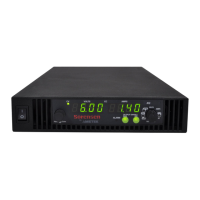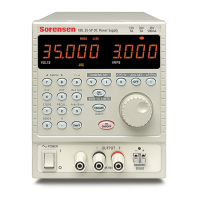Remote Operation
5-70 M370430-01 Rev B
Where:
<delay_time> is a value in the range of 0.5-50 seconds. The unit of
second is the default and no units should be used with this parameter.
(Increments of 0.1 seconds are allowed.). The default value is 0.5
seconds.
Over Temperature Protection
The over temperature protection (OTP) is the alarm that protects the unit
in case of ventilation blockage, fan failure, or some other event that
causes the unit to overheat. The OTP cannot be masked to disable it. The
OTP alarm can have its output latch on clearing. See “Alarm Output
Latching” on page 3-25.
The SCPI command (s) for these instructions are:
[:]SYSTem[<channel(s)>]:PROTection:LATCh
The On setting shown by the front panel (“Using Over Temperature
Protection Lock (OTP)” on page 3-32), maps to having the OTP latch
flag set. The OFF setting maps to having the OTP latch flag cleared. The
default is to have the flag cleared.
Loop Protection Enable/Disable
The Loop Protection is described in “Loop Protection” on page 3-34.
Enabling Loop Protection (LOOP PRO on front panel) will allow the
Loop Protection feature to trigger based on the conditions described in
“Loop Protection”, page 3-34. This feature can be controlled by either
front panel operation or SCPI command as shown below. The default
value of Loop Protection is set to Disabled.
Important: While Loop Protection is enabled (set to ON), the external
shutdown function will be automatically set to low active. When Loop
Protection is disabled (set to OFF), the external shutdown function will be set to
the user’s last setting.
Commands:
[:]OUTPut[<channel>]:PROTection:LOOP{?|ON|OFF}
Where
ON enables the use of Loop protection. Returns 1.
OFF disables the use of Loop protection. Returns 0.
Interlock Enable/Disable
The Interlock feature is explained in “Interlock Function” on page 3-36.
Use the command below to enable and disable interlock. Enabling
interlock will allow the interlock feature to trigger based on the
conditions described in “Interlock Function” on page 3-36. This feature

